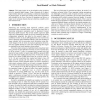34 search results - page 1 / 7 » Using simplified event calculus in digital investigation |
SAC
2008
ACM
13 years 4 months ago
2008
ACM
In a hypothesis-based approach to digital investigation, the investigator formulates his hypothesis about which events took place, and tests them using the evidence available. A f...
ECAI
2006
Springer
13 years 8 months ago
2006
Springer
This paper reports on an investigation using occlusion calculi to interpret digital images. Using a minimal set of digital, region-relation detectors, and assuming a continuous int...
RTSS
2009
IEEE
13 years 11 months ago
2009
IEEE
Abstract—Many embedded platforms consist of a heterogeneous collection of processing elements, memory modules, and communication subsystems. These components often implement diff...
ISSA
2008
13 years 6 months ago
2008
Digital evidence is not well perceived by the human senses. Crucial pieces of digital evidence may simply be missed by investigators as the forensic significance of seemingly unim...
AIRS
2004
Springer
13 years 10 months ago
2004
Springer
Abstract. Cross-lingual event tracking from a very large number of information sources (thousands of Web sites, for example) is an open challenge. In this paper we investigate effe...

